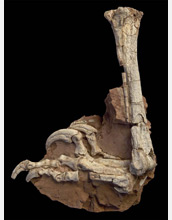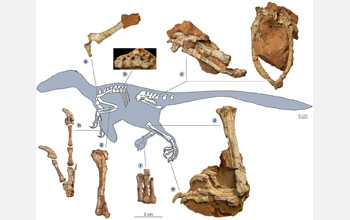All Images
News Release 10-158
"Stocky Dragon" Dinosaur Terrorized Late Cretaceous Europe
Balaur bondoc used extendable claws to attack and tear apart prey
This material is available primarily for archival purposes. Telephone numbers or other contact information may be out of date; please see current contact information at media contacts.

The fossilized hindlimb of Balaur bondoc shows the double-sickle claws of the foot, one of 20 unique features found on the animal, which lived on a Late Cretaceous island in what is now Europe.
Credit: Mick Ellison
Download the high-resolution JPG version of the image. (117 KB)
Use your mouse to right-click (Mac users may need to Ctrl-click) the link above and choose the option that will save the file or target to your computer.

Play Audio
Lead author Zoltan Csiki of the University of Bucharest and co-author Mark Norell of the American Museum of Natural History describe the new dinosaur Balaur bondoc, and how it was found, in an audio call-in program with NSF.
Credit: National Science Foundation

A reconstruction shows the skeletal anatomy of Balaur bondoc. While only a few bones exist, they reveal a great deal about the organism, and represent one of the most complete predatory dinosaur skeletons from the middle to Late Cretaceous of Europe.
Credit: Mick Ellison; Zoltan Csiki; Matyas Vremir; Stephan Brusatte; Mark Norell; AMNH
Download the high-resolution JPG version of the image. (543 KB)
Use your mouse to right-click (Mac users may need to Ctrl-click) the link above and choose the option that will save the file or target to your computer.


